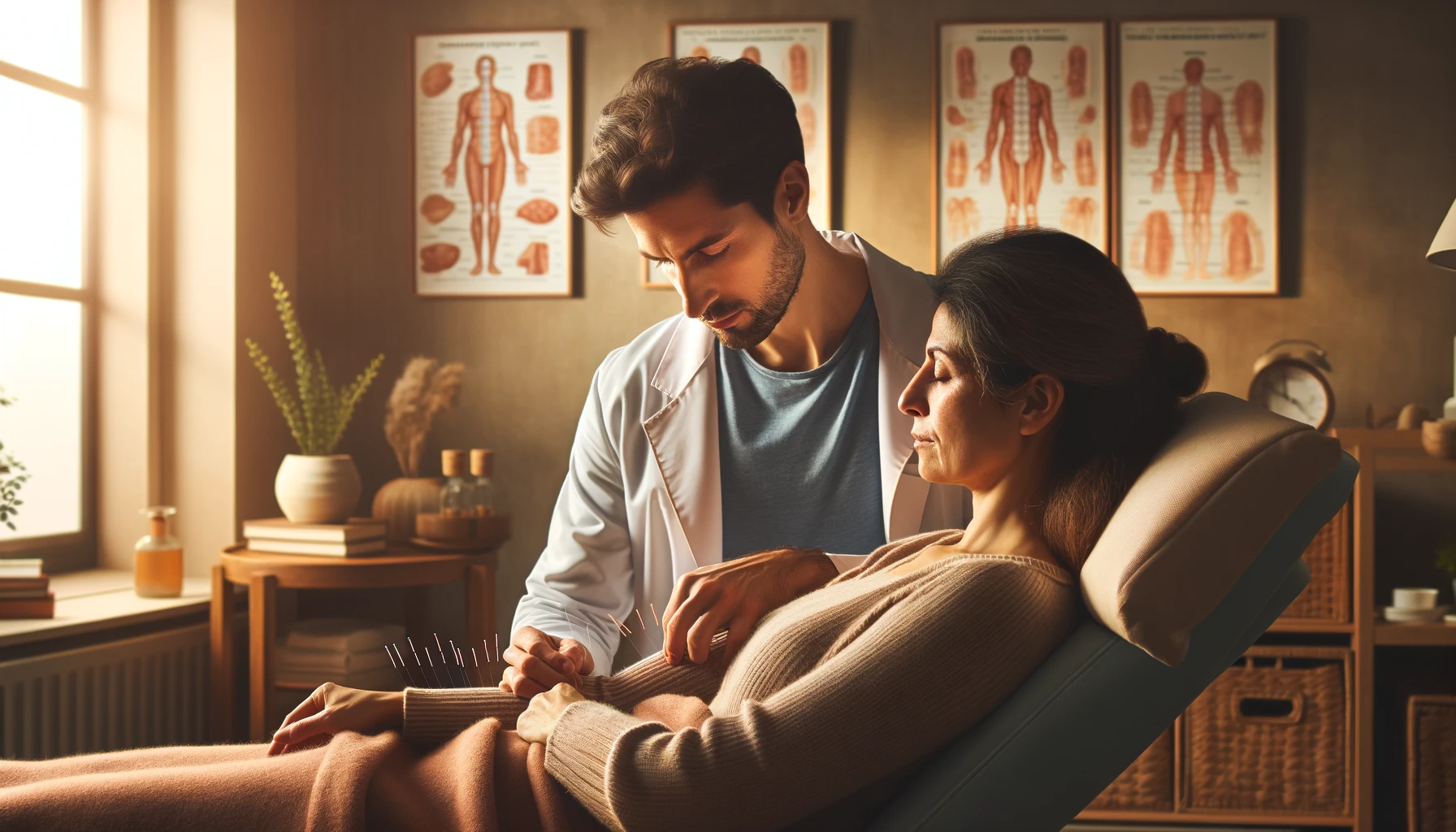
Acupuncture has long been a part of traditional Chinese medicine, but does it really work? As a journalist specializing in health and wellness, I’ve delved into the research to explore the effectiveness of acupuncture and the science behind it.
Scientific studies have shown that acupuncture can provide relief for chronic pain, headaches, and migraines. It has also been found to have positive effects on mental health conditions such as depression and anxiety. The release of endorphins and other neurotransmitters during acupuncture treatments is thought to contribute to its therapeutic effects.
While ongoing research is still being conducted, acupuncture has shown promising results in relieving symptoms and improving overall health. Join me as we dive deeper into the fascinating world of acupuncture and its potential benefits.

Key Takeaways:
- Scientific studies have shown that acupuncture is effective in treating chronic pain, headaches, and mental health conditions.
- The release of endorphins and other neurotransmitters during acupuncture contributes to its therapeutic effects.
- Acupuncture has shown promising results in relieving symptoms and improving overall health.
- Ongoing research is being conducted to further understand the science behind acupuncture.
- Consulting with a licensed acupuncturist can provide personalized guidance on incorporating acupuncture into a comprehensive healthcare plan.
A Brief History of Acupuncture
Acupuncture has a rich history that dates back thousands of years and is rooted in traditional Chinese medicine. The practice of acupuncture revolves around the concept of Qi, the body’s energy flow. Acupuncture points, also known as meridians, are believed to be connected to this energy flow.
Practitioners stimulate these acupuncture points by inserting thin needles into the skin, aiming to improve the flow of Qi and promote overall health. The origins of acupuncture can be traced back to ancient China, where it was developed as a holistic approach to healthcare. Over the centuries, acupuncture has evolved and been refined, becoming an integral part of both traditional Chinese medicine and Western medicine.
The Significance of Acupuncture Points
Acupuncture points, or meridians, are strategically located throughout the body. Each acupuncture point is associated with specific organs or bodily functions. By targeting these points, acupuncturists can address imbalances and optimize the body’s natural healing processes. Traditional Chinese medicine teaches that stimulating these points helps to restore the flow of Qi and maintain overall health.
| Acupuncture Point | Associated Organ/Function |
|---|---|
| LI4 (Hegu) | Head and face, immune system |
| ST36 (Zusanli) | Digestive system, energy levels |
| LV3 (Taichong) | Liver function, stress relief |
| KI3 (Taixi) | Kidney function, sleep quality |
The acupuncture points chosen for treatment are based on the patient’s specific condition and symptoms. By targeting these points, acupuncturists can address a wide range of health issues, from chronic pain to mental health concerns.
“Acupuncture has a long and esteemed history, with origins in traditional Chinese medicine. Through the stimulation of acupuncture points, practitioners aim to restore the body’s natural balance and promote overall well-being.”
The practice of acupuncture has stood the test of time and continues to be used today due to its effectiveness in promoting health and alleviating various conditions. Whether as a standalone treatment or as a complementary therapy alongside conventional medicine, acupuncture offers a holistic approach to wellness that has resonated with individuals seeking natural healing methods.
The Philosophy and Mechanism of Acupuncture
Acupuncture is rooted in different philosophies that guide its practice. Some practitioners attribute its success to the concept of Qi and meridians, while others view acupuncture points as physical areas that respond to stimulation. Regardless of the belief system, the mechanism of acupuncture involves the use of thin needles inserted into specific points on the body to trigger various physiological responses.
When an acupuncture point is stimulated, it is believed to elicit increased blood flow and activate the body’s pain-relieving system. This process may induce the release of endorphins, reduce inflammation, and modulate the nervous system. While the exact mechanism is still being studied, it is thought to involve complex interactions among the nervous system, hormones, and the immune system.
Acupuncturists carefully select the acupuncture points based on their knowledge of the interconnectedness of the body. Each point has a specific relationship to certain conditions and symptoms, allowing practitioners to target the root cause of an ailment. By considering the individual’s unique constitution and health history, acupuncturists tailor treatments to address the underlying imbalances contributing to the person’s health concerns.

Understanding Acupuncture Points
One key aspect of acupuncture is the identification and utilization of acupuncture points. These points are specific locations on the body where the needle is inserted. They are often found along pathways known as meridians, which are believed to channel the flow of Qi, or vital energy.
Acupuncture points have been mapped out over thousands of years, with each point serving a specific purpose. For example, the point known as “LI4” is commonly used for pain relief and immune system modulation, while “ST36” is often used to support digestion and boost energy.
Acupuncturists rely on their extensive training and knowledge of these points to develop effective treatment plans. By strategically selecting and stimulating acupuncture points, they aim to restore balance and promote overall well-being in their patients.
| Common Acupuncture Points | Location | Function |
|---|---|---|
| GB20 (Gallbladder 20) | Located at the base of the skull, in the hollows on each side of the neck. | Used for headache relief, neck pain, and stress reduction. |
| LI4 (Large Intestine 4) | Found on the hand, in the webbing between the thumb and index finger. | Known for its analgesic effects and immune system regulation. |
| SP6 (Spleen 6) | Located on the inner side of the lower leg, about four finger widths above the ankle bone. | Used for fertility support, menstrual pain, and digestive issues. |
| LR3 (Liver 3) | Found on the top of the foot, in the depression between the first and second toe bones. | Used for stress reduction, eye issues, and promoting smooth Qi flow. |
Acupuncture stimulates the body’s natural healing mechanisms and promotes self-regulation. By selecting and stimulating specific acupuncture points, acupuncturists tap into the body’s innate ability to restore balance and enhance overall health.
Common Uses of Acupuncture Therapy
Acupuncture is a versatile therapy that has been used for centuries to treat various health conditions and promote overall well-being. Its effectiveness has been demonstrated in relieving pain, reducing stress levels, and improving mental health. Here are some common uses of acupuncture therapy:
Pain Relief
Acupuncture is widely utilized for pain relief, particularly for chronic pain and nerve-related conditions. Studies have shown that acupuncture can help alleviate pain caused by arthritis, migraines, back pain, and fibromyalgia. By stimulating specific acupuncture points, the treatment promotes the release of endorphins, which are natural pain-relieving substances in the body. This provides patients with a natural and drug-free alternative for managing their pain.
Stress and Anxiety Reduction
Many individuals turn to acupuncture as a way to manage stress and anxiety. Acupuncture treatments can help regulate the nervous system and promote a sense of calm and relaxation. By targeting specific acupuncture points, the therapy stimulates the release of neurotransmitters such as serotonin, which plays a role in regulating mood and emotions. Regular acupuncture sessions can help individuals cope with stress, reduce anxiety symptoms, and promote overall mental well-being.
Insomnia Treatment
Acupuncture has shown promise in treating insomnia and improving sleep quality. By targeting specific acupuncture points that correspond to sleep regulation, the therapy can help individuals achieve a more restful and uninterrupted sleep. The treatment promotes the release of melatonin, a hormone that regulates sleep-wake cycles, and aids in relaxation. Acupuncture can be a valuable complementary therapy for those struggling with sleep issues.

Fertility Support and Weight Management
Acupuncture is also commonly used as a complementary therapy for fertility treatments. By improving blood flow to the reproductive organs and regulating hormone levels, acupuncture can enhance fertility and increase the chances of successful conception. Additionally, acupuncture has been explored as a potential aid in weight loss efforts. The therapy can help suppress appetite, decrease cravings, and support overall metabolism, making it a valuable tool for individuals seeking to achieve weight loss goals.
As with any treatment, it is important to consult with a licensed acupuncturist to discuss your specific health concerns and develop a personalized treatment plan. Acupuncture can be a valuable addition to your healthcare routine, providing natural and holistic support for a wide range of conditions.
Scientific Evidence for Acupuncture
Scientific studies on acupuncture have provided promising evidence for its efficacy in treating various conditions. While designing placebo-controlled studies for acupuncture can be challenging, research has indicated positive outcomes for chronic pain management, including back pain, headaches, neck pain, and knee pain(acupuncture for chronic pain). In a study conducted by Vickers et al., it was found that acupuncture was more effective than sham acupuncture or no acupuncture in reducing chronic pain(acupuncture scientific studies).
Another area where acupuncture has shown effectiveness is in the treatment of migraines. A meta-analysis of multiple randomized controlled trials concluded that acupuncture can reduce the frequency of migraines when combined with standard medical care(acupuncture for migraines). The study found that acupuncture significantly reduced the number of days with migraines and the intensity of pain experienced by patients.
These findings support the use of acupuncture as a complementary therapy in the management of chronic pain and migraines. It provides an alternative treatment option for individuals who may be looking for natural pain relief without relying solely on pharmaceutical interventions. While further research is necessary to fully understand the mechanisms of acupuncture, the existing scientific evidence showcases its potential benefits for individuals seeking non-invasive and holistic approaches to their healthcare.
Scientific Studies on Acupuncture:
| Study | Condition | Results |
|---|---|---|
| Takakura et al., 2010 | Chronic low back pain | Acupuncture significantly reduced pain intensity and improved function compared to sham acupuncture |
| Vickers et al., 2012 | Osteoarthritis of the knee | Acupuncture showed a moderate benefit in reducing pain and improving physical function |
| Linde et al., 2016 | Migraines | Acupuncture reduced the frequency of migraines and had a positive impact on quality of life |
While these studies provide promising evidence, it is important for individuals to consult with a licensed acupuncturist to assess their specific condition and develop a personalized treatment plan(acupuncture efficacy). Acupuncture may not be suitable for everyone, and it is important to consider the individual’s overall health, medical history, and any underlying conditions.
Risks and Limitations of Acupuncture
While acupuncture is generally considered safe when performed by a licensed acupuncturist, it is important to be aware of the potential risks and limitations associated with this therapy. One of the main risks is the possibility of minor bleeding or bruising at the acupuncture site. This is a relatively rare occurrence, but it is important to inform your acupuncturist if you have a bleeding disorder or are taking blood-thinning medications.
Another limitation of acupuncture is that it primarily focuses on relieving symptoms rather than addressing the underlying cause of health conditions. It is important to approach acupuncture as a complementary therapy alongside conventional medical treatments. Consulting with your healthcare provider can help you develop a comprehensive treatment plan that combines acupuncture with other appropriate interventions.
“Acupuncture is generally considered safe when performed by a licensed acupuncturist.”
It is also worth noting that acupuncture may not be covered by insurance, which could result in out-of-pocket expenses. Before starting treatment, it is advisable to check with your insurance provider to understand the coverage and potential costs involved. Many licensed acupuncturists offer affordable payment plans for those without insurance coverage.
| Risks of Acupuncture | Limits of Acupuncture |
|---|---|
| Minor bleeding or bruising | Focuses on symptom relief |
| Rare occurrence | Complementary therapy |
| Inform acupuncturist of bleeding disorders or blood-thinning medications | Collaborate with healthcare provider for comprehensive treatment plan |
| Possible out-of-pocket expenses | Insurance coverage may vary |
Overall, it is essential to approach acupuncture with realistic expectations and a clear understanding of its risks and limitations. By working closely with a licensed acupuncturist and integrating acupuncture into a comprehensive healthcare plan, you can maximize the benefits of this ancient practice and enhance your overall well-being.
Misconceptions About Acupuncture
Acupuncture has gained popularity as an alternative therapy for various conditions, but there are still misconceptions surrounding this ancient practice. Let’s debunk some of the common myths and address the concerns that may deter individuals from exploring the benefits of acupuncture.
Myth 1: Acupuncture is Painful
Contrary to popular belief, acupuncture is not a painful experience. The needles used in acupuncture are ultra-thin and designed to minimize discomfort during insertion. Most patients report feeling a mild sensation, if anything, as the needles are gently placed on the skin. The experience is generally described as relaxing and soothing.
Myth 2: Acupuncture is Mystical
While the concepts behind acupuncture may seem mystical to some, there is scientific evidence supporting its efficacy. Modern research has shown that acupuncture can stimulate the release of endorphins, which are the body’s natural painkillers. It can also influence neurotransmitters and modulate neural pathways to promote healing and overall well-being. Acupuncture is rooted in ancient wisdom but is firmly grounded in scientific principles.
Myth 3: Acupuncturists Lack Medical Training
Acupuncturists undergo extensive education and training to become licensed professionals. They typically receive four years of specialized training from accredited acupuncture schools, where they study not only the techniques of acupuncture but also anatomy, physiology, and other fundamental medical sciences. Acupuncture is a complementary therapy that can work in conjunction with conventional medical treatments, and licensed acupuncturists are an integral part of the healthcare system.
By dispelling these misconceptions, we can empower individuals to make informed decisions about incorporating acupuncture into their healthcare journey. Acupuncture is a safe and effective therapy that can provide relief from various conditions and promote holistic well-being.
Conclusion: The Efficacy of Acupuncture
After exploring the science, history, and applications of acupuncture, it is evident that this ancient practice holds significant promise in promoting overall wellness and providing natural pain relief. While ongoing research is unraveling the precise mechanisms of acupuncture, scientific studies have already shown its effectiveness in treating various conditions, including chronic pain, migraines, stress, and anxiety.
Acupuncture is not just a standalone therapy; it can also be a valuable complement to traditional medical treatments. By working in conjunction with other healthcare strategies, acupuncture can enhance the overall efficacy and success of treatment plans. Its ability to address symptoms and promote the body’s self-healing mechanisms makes it a versatile and holistic approach to healthcare.
It is important to recognize that acupuncture is not a mystical or pseudoscientific practice. Licensed acupuncturists undergo extensive education and training, ensuring that they are highly qualified healthcare professionals. The growing body of scientific evidence dispels any misconceptions and highlights the credibility and efficacy of acupuncture.
If you are considering acupuncture as a complementary therapy or seeking natural pain relief, consulting with a licensed acupuncturist can provide personalized guidance and a comprehensive healthcare plan tailored to your specific needs. With its long history and ongoing research, acupuncture continues to be an effective and respected option for those looking to improve their overall well-being.
FAQ
Is acupuncture painful?
Most patients do not experience significant pain during acupuncture treatments. Sensations may vary but are often described as mild or a slight tingling sensation.
How does acupuncture work?
The exact mechanism of how acupuncture works is still being studied. It is believed to involve the nervous system, hormones, and immune system responses. By stimulating acupuncture points, it is thought to trigger increased blood flow and stimulate the body’s pain-relieving system.
What conditions can acupuncture be used for?
Acupuncture therapy can be used for various conditions, including chronic pain, headaches, migraines, stress, anxiety, depression, insomnia, fertility issues, and weight loss, among others. It is best to consult a licensed acupuncturist to discuss specific treatment options.
Are there scientific studies supporting acupuncture?
Yes, there are nearly 4,000 scientific studies conducted on acupuncture. Research has shown its efficacy in treating chronic pain, migraines, and reducing PTSD symptoms, among other conditions.
Is acupuncture safe?
Yes, when performed by a licensed acupuncturist, acupuncture is generally considered safe. The use of sterile, one-time-use needles minimizes the risk of infection. However, there may be minor bleeding or bruising at the acupuncture site.
What are the limitations of acupuncture?
The main limitation of acupuncture is that it primarily focuses on relieving symptoms rather than addressing underlying health conditions. It is important to consult a licensed acupuncturist and discuss any potential risks or limitations before starting treatment.
What are some misconceptions about acupuncture?
Some common misconceptions about acupuncture include that it is painful, mystical in nature, and that acupuncturists lack medical training. In reality, acupuncture is generally not painful, there is scientific evidence supporting its efficacy, and licensed acupuncturists undergo rigorous education and clinical experience.



